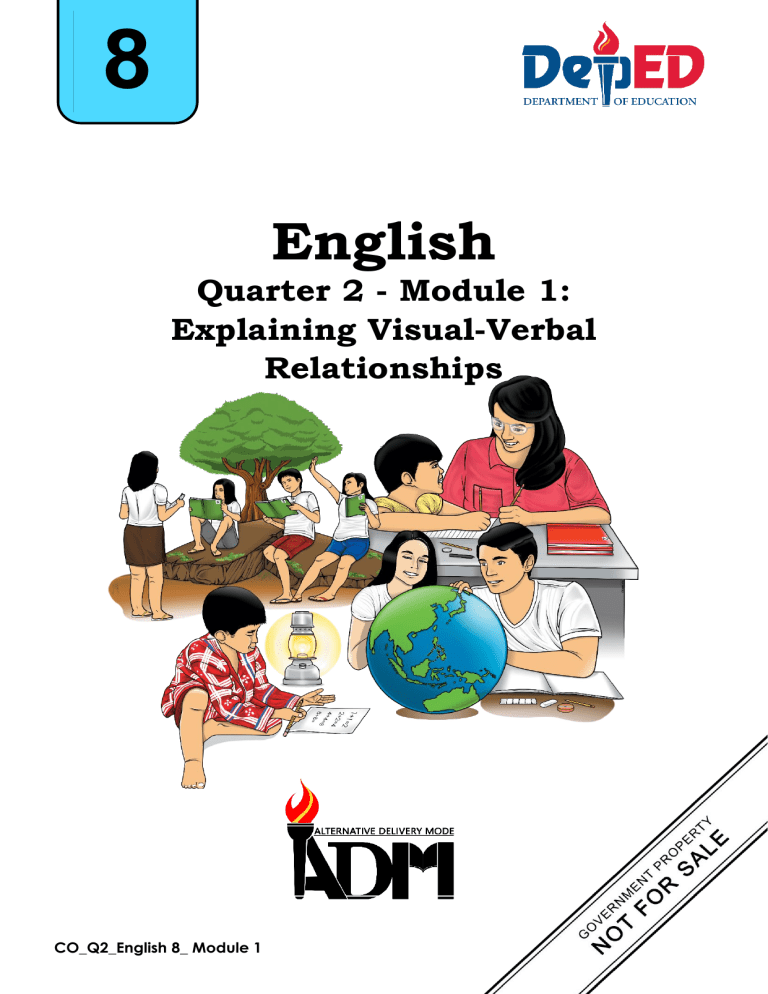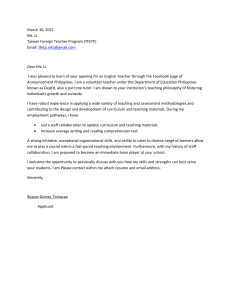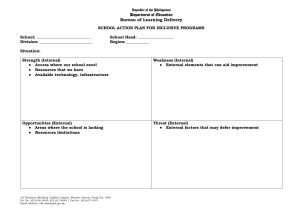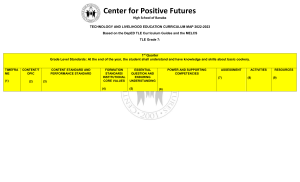
8 English Quarter 2 - Module 1: Explaining Visual-Verbal Relationships CO_Q2_English 8_ Module 1 English – Grade 8 Alternative Delivery Mode Quarter 2 – Module 1: Explaining Visual-Verbal Relationships First Edition, 2020 Republic Act 8293, section 176 states that No copyright shall subsist in any work of the Government of the Philippines. However, prior approval of the government agency or office wherein the work is created shall be necessary for exploitation of such work for profit. Such agency or office may, among other things, impose as a condition the payment of royalties. Borrowed materials (i.e., songs, stories, poems, pictures, photos, brand names, trademarks, etc.) included in this book are owned by their respective copyright holders. Every effort has been exerted to locate and seek permission to use these materials from their respective copyright owners. The publisher and authors do not represent nor claim ownership over them. Published by the Department of Education Secretary: Leonor Magtolis Briones Undersecretary: Diosdado M. San Antonio Development Team of the Module Writer: Editors: Reviewers: Cris-An T. Gabing Tammy C. Catubig, Vanessa R. Natulla Gladys S. Asis, Maria Dinah D. Abalos, Fe M. Dizon, Elnora T. Ordedor, Grace H. Balagot, Kristoffer Ian F. Basco, Lucita G. Besonia, Imie Concepcion C. Valdez, Elsie Joy B. Leal, Venus Sheila O. Ayado, Carolina A. Curtina, Hazel P. Yabo, Genalyn M. Dispo, Mark Joseph T. Delima, Immanuel S. Nono, Joshua L. Albia Layout Artist: Anselmo S. Osores Jr., Ria V. Omaña Management Team: Francis Cesar B. Bringas Isidro M. Biol, Jr. Maripaz F. Magno Josephine Chonie M. Obseñares Bebelyn C. Corvera Donald D. Orbillos Israel B. Reveche Printed in the Philippines by ________________________ Department of Education – Region XIII Office Address: Learning Resource Management and Development Center Teacher Development Center J.P. Rosales Avenue, Butuan City, Philippines 8600 Telefax: (085) 342-8207/ (085) 342-5969 E-mail Address: caraga@deped.gov.ph 8 English Quarter 2 - Module 1: Explaining Visual-Verbal Relationships Introductory Message This Self-Learning Module (SLM) is prepared so that you, our dear learners, can continue your studies and learn while at home. Activities, questions, directions, exercises, and discussions are carefully stated for you to understand each lesson. Each SLM is composed of different parts. Each part shall guide you step-bystep as you discover and understand the lesson prepared for you. Pre-tests are provided to measure your prior knowledge on lessons in each SLM. This will tell you if you need to proceed on completing this module or if you need to ask your facilitator or your teacher’s assistance for better understanding of the lesson. At the end of each module, you need to answer the post-test to self-check your learning. Answer keys are provided for each activity and test. We trust that you will be honest in using these. In addition to the material in the main text, Notes to the Teacher are also provided to our facilitators and parents for strategies and reminders on how they can best help you on your home-based learning. Please use this module with care. Do not put unnecessary marks on any part of this SLM. Use a separate sheet of paper in answering the exercises and tests. And read the instructions carefully before performing each task. If you have any questions in using this SLM or any difficulty in answering the tasks in this module, do not hesitate to consult your teacher or facilitator. Thank you. Lesson 1 Explaining Visual-Verbal Relationships What I Need to Know The scope of this module permits it to be used in many different learning situations. The lessons are arranged to follow the standard sequence of the course. After going through this module, you are expected to explain visual-verbal relationships illustrated in tables, graphs, and information maps found in expository texts ( EN8SS – lle 1.2 MELC). Specifically, you are expected to: 1. analyze visual-verbal relationships through tables, graphs, infographics, and information maps; 2. interpret information presented in a text; and 3. demonstrate appreciation a concept map. and understanding of expository text through 1 CO_Q2_English 8_ Module 1 What I Know In this part of the module, you are going to answer the given activity by interpreting verbalvisual relationships using graphs, tables, and information maps. Directions: Analyze closely the given verbal-visual presentations through graphs, infographics, tables, and information maps. Write the letter of your answer on a separate sheet. 1. In the concept map below, which one is NOT a part of speech? A. adjective B. adverb C. modal Adjective Adverb Parts of Speech Verb Noun D. verb Preposition Conjunction Interjection Pronoun 2. The map below shows that ________________. A. Europe is part of Asia B. Antarctica is the largest continent C. Australia is the smallest continent D. North and South America are considered as one continent . Source: "BALS: The World According To The Map". 2014. Deped LR Portal. https://lrmds.deped.gov.ph/detail/6458 2 CO_Q2_English 8_ Module 1 For items 3-4, please refer to the chart below. Below is a pie chart showing Anthony’s monthly expenses. ANTHONY'S MONTHLY EXPENSES Education 19% House Rental 23% Electric Bill 12% Food 38% Clothing 8% 3. Which part of the pie has the biggest monthly budget of Anthony’s expenses? A. education B. electric bill C. food D. house rental 4. How many percent is the budget for house rental? A. 8% B. 12% C. 19% D. 23% For items 5-6, please refer to the table below. Grade 8 Modalities of Learning Section Rizal Section Arellano Total Radio 1 2 3 Television 4 4 8 Online Learning 13 9 22 Modular Learning 23 26 49 Blended Learning 7 6 13 Total 48 47 95 5. How many students choose online learning? A. 9 B. 13 C. 22 6. Which learning modality do students like the most? A. modular learning B. online learning C. radio D. 48 D. television 3 CO_Q2_English 8_ Module 1 For items 7-8, please refer to the graph below. Votes for the Favorite Sports 30 Number of Votes 25 20 15 10 5 0 BADMINTON CHESS BASKETBALL VOLLEYBALL 7. Which sport has the highest number of votes? A. Badminton B. Basketball C. Chess D. Volleyball 8. What conclusion can be drawn from the graph? A. All sports have the same votes. B. Basketball is the favorite sports of most students C. People have the same interests in sports. D. Volleyball has the highest number of votes. For items 9-11, please refer to the graph below. Below is the line graph showing the monthly income of Ms. Dynah’s perfume business. Monthly Income of Ms. Dynah MONTHLY INCOME IN PESO 7000 6000 6000 5000 4500 4000 4000 4000 3500 3000 3000 2500 2500 2000 1500 1000 0 850 900 FEB MAR 400 JAN APR MAY JUNE JUL AUG 9. In which month does Ms. Dynah earn the highest? A. July B. October C. November SEPT OCT NOV DEC D. December 10. How much is the increase of Ms. Dynah’s income from May to June? A. P 500.00 B. P 1,000.00 C. P 1,500.00 D. P 2,000.00 4 CO_Q2_English 8_ Module 1 11. Based on the given data in the graph, what will likely happen to the perfume business of Ms. Dynah? A. Her perfume business will boom. B. Her perfume business will be closed. C. Her perfume business will start to fail. D. Her perfume business will just break even. For items 12-13, please refer to the flowchart below. Proper Hand Washing Wet hands with running water. Apply soap to lather, and rub hand surface for 20 seconds. Rub right hand over left and vice versa. Rub the backs of fingers against the opposite palm. Rub palms together with fingers interlaced. Grasp thumb and rub with a twisting motion. Repeat to other thumb. Rub left palm against the back of the right hand and vice versa. Rinse hands with running water. Dry hands on the air or wipe with a clean cloth. . Source: "Get Ready For Disasters: Workbook For Intermediate Students". 2016. Deped LR Portal. https://lrmds.deped.gov.ph/detail/11265. 12. How many seconds do you need to wash your hands? A. 10 seconds B. 15 seconds C. 17 seconds D. 20 seconds 13. Which is NOT the main purpose of hand washing? A. To eliminate the presence of viruses B. To spread the viruses and diseases C. To prevent the spread of viruses D. To maintain proper hygiene 5 CO_Q2_English 8_ Module 1 For items 14-15, please refer to the infographic below. Source: "How To Make Drinking Water Safe". 2015. Deped LR Portal. https://lrmds.deped.gov.ph/detail/10578. 14. What is the BEST explanation why water must be filtered before it becomes drinkable or potable? A. To prevent us from dehydration B. To enjoy the benefits of the water C. To contain bacteria and microbes present in water D. To eliminate dirt, minerals, chemicals, and other impurities 15. Which of the following statements does NOT explain what the infographic is all about? A. The infographic illustrates the acidity of water. B. The infographic presents how to get drinking water. C. The infographic tells that ordinary water can be potable or drinkable. D. The infographic shows the step by step procedures of making water safe for drinking. 6 CO_Q2_English 8_ Module 1 What’s In You have learned from your previous lesson how to use a range of verbs, adjectives, and adverbs in expressing emotional responses and reactions to an issue. Directions: Fill in the blanks in the concept map with the correct words from the box below to complete the idea of each sentence. Write your answers on a separate sheet. personally definitely must sad delighted ______, we had better follow the rules implemented during the pandemic or else the virus will continue to spread. As your friend, I will be _________ if you share your problems with me. Adjective Adverb Use a range of verbs, adjectives, and adverbs Verb Senior citizens and minors ______ stay at home during this COVID pandemic. 7 CO_Q2_English 8_ Module 1 You have learned from the concept map above about using a range of verbs, adjectives, and adverbs in expressing emotional responses and reactions. A concept map is an example of a visual-verbal illustration. What’s New Have you ever presented your ideas to a group of people? If so, were you able to present your ideas clearly? What do you usually use in presenting your ideas? Look at the illustrations below. Which of the two would you like to use in presenting the given idea? Draw a to your choice on the space provided. The term ‘cultural heritage’ 1.has changed content considerably in recent decades, partially owing to the instruments developed by the Oral Traditions Performing Arts United Nations Educational, Scientific and Cultural Organization (UNESCO). Cultural heritage does not end at monuments and collections of objects. It also includes traditions or living expressions inherited from our ancestors and passed on to our descendants, such as oral traditions, performing arts, social practices, rituals, and festive events. Traditional skills Cultural Heritage Festive Events & Rituals Social Practices Monuments and collections of objects Source: Anama, Gina, Anna Lea Davide, Ricardo Ador Dionisio, Lerma Flandez, Armi Victoria Fiangaan, Marcelino Ibañez, and Gizelle V. Laud et al. Voyages In Communication – Grade 8. 1st ed. Pasig City: Department of Education, 2013. Illustration 1. _______ • • • Illustration 2. ________ Why did you choose such an illustration? What ideas are presented in the two illustrations? Are they the same? How are the ideas presented in the two illustrations? The illustrations above are examples of visual-verbal illustrations. 8 CO_Q2_English 8_ Module 1 What is It As you continue, you will learn the different types of visual-verbal illustrations to help you simplify the presentation of information in expository texts. What are visual-verbal illustrations? Visual-verbal illustrations are the ways of presenting information in a simple and attractive manner to catch the readers’ interest. These illustrations help explain concepts easily using graphs, maps, tables, infographics, charts and the like. Below are the commonly used visual-verbal illustrations. 1. Graph is a diagram that shows the relationships of information presented. Below are the different kinds of graphs. a. Line Graph is a kind of graph that presents information trends using data dots connected by straight line segments. NUMBER OF CASES C O V ID - 1 9 C AS E S IN T H E P H IL IP P IN E S F R O M MAR C H - J U N E 2 0 2 0 40000 37514 30000 20000 18086 10000 8488 2084 0 MARCH APRIL MAY JUNE The line shows the increase of the number of COVID-19 cases from March - June 2020. b. Bar Graph is a kind of graph that characterizes categorical data with rectangular bars of equal width. Number of Cases COVID-19 Cases in the Philippines from March-June 2020 40000 30000 20000 10000 0 March April May June The bar graph above shows the increase of the number of COVID-19 cases from March-June 2020. 9 CO_Q2_English 8_ Module 1 2. Table is an organized arrangement of data usually in rows and columns. Enrollment of Kampupot National High School SY 2019-2020 Enrollment Data Grade 8 Section Male Female Total Gumamela 20 30 50 Rose 25 20 45 Sampaguita 20 28 48 Total 65 78 143 The table shows the enrollment data of the three Grade 8 sections in which section Gumamela has the highest number of students (50), followed by section Sampaguita (48), and lastly, section Rose (45). 3. Map is a diagram or visual representation that shows the relative position of the parts of something. It could be a drawing or a photograph. Luzon Visayas Mindanao The illustration shows the Philippine Map. 10 CO_Q2_English 8_ Module 1 4. Concept map displays the organization and relationship of concepts and ideas. Laguna Tarlac Nueva Ecija Eight cities representing the eight rays of the sun in the Philippine flag Manila Cavite Pampanga Batangas Bulacan The concept map shows the eight cities representing the eight rays of the sun in the Philippine flag. 5. Chart is an illustration that presents information in a tabular or circular form. These are the different kinds of charts. a. Pie Chart is circular in form that presents how a whole is sliced into parts. COVID-19 CASES IN THE PHILIPPINES FROM MARCH-JUNE 2020 March June April May Source: "Home - COVID 19 PH Official Website". COVID 19 PH Official Website, 2020. http://www.covid19.gov.ph/. The pie chart above shows the increase of the number of COVID-19 cases from March-June 2020. 11 CO_Q2_English 8_ Module 1 b. Flowchart is an illustration that shows a step-by-step process. PROCESS OF ENROLLMENT Get the Learner Enrollment and Survey Form (LESF) from the school guard or from the barangay personnel. Fill out the LESF completely and correctly. Submit it to the school guard or barangay personnel. You can also drop it in the drop box provided. The flow chart above shows the process of enrollment. 6. Infographic is a combination of visual images and text presentation of specific information. Source: "Get Ready For Disasters: Workbook For Intermediate Students". 2016. Deped LR Portal. https://lrmds.deped.gov.ph/detail/11265. The infographic material contains rainfall advisory and people’s appropriate response. 12 CO_Q2_English 8_ Module 1 What’s More This time, you will practice what you have learned on visual-verbal illustrations about graphs, tables, maps, concept maps, charts, and infographics. Read and do what is asked in each activity below. Activity 1. Match Me Directions: Match the definition found in column A with the appropriate illustration found in column B. Write your answers on a separate sheet. A 1. It is circular in form that presents how a whole is sliced into parts. B a. Bar Graph 6 4 2 0 Category 1 Category 2 Category 3 Category 4 Pie Chart 2 It displays the organization and relationship of concepts and ideas. b. 4th Qtr 3rd Qtr 1st Qtr 2nd Qtr 3. It is an organized arrangement of data usually in rows and columns. Concept Map c. 13 CO_Q2_English 8_ Module 1 4. It is a kind of graph that presents information trends using data dots connected by straight line segments. d. 5. It is a graph that characterizes categorical data with rectangular bars of equal width. e. Table Nutritional Status of Grade 8 Gumamela Name Underweight Normal Overweight Line Graph 6 4 2 0 Category 1 Category 2 Category 3 Series 1 Series 2 Category 4 Assessment 1: Check Me Directions: Put a check mark (✓) in the box if the statement is true. Put an (X) mark if the statement is false. Write your answers on a separate sheet. 1. Chart is an illustration that presents information in a tabular or circular form. 2. Map is in a tabular form that shows the relative position of the parts of something. 3. Flow chart is an illustration that shows a step-by-step process. 4. Table is a circular arrangement of data usually in rows and columns. 5. Line Graph is a kind of graph that presents information trends using data dots connected by straight line segments. 6. Bar Graph is a kind of graph that characterizes categorical data with rectangular bars of equal width. 7. Pie Chart is circular in form that presents how a whole is sliced into parts. 8. Concept map displays the organization and relationship of concepts and ideas. 9. Graph is a diagram that shows the relationships of information presented. 10. Infographic is a combination of visual images and text presentation of specific information. 14 CO_Q2_English 8_ Module 1 Activity 2: Be Ready Read and take note of the important details mentioned in the selection below. EARLY WARNING There are some ways we can learn that a disaster is coming, like monitoring the weather, observing increasing water levels in rivers, or knowing that a tsunami often follows an earthquake. There are different people who can keep you informed about what you should do and where you can go. This could be your family, neighbors, and the media. Sometimes, police or local officials will also inform you if you need to leave your home. You may even have a local RC 143 Disaster Management Team that will help you in these times, guiding you on when to evacuate, what to bring, and where to go to stay safe in times of disaster. Your community may have a local warning system to announce if a hazard is approaching. This warning system could be a megaphone, a bell, a rain gauge, a colored flag, or a bamboo clapper. It’s important to listen, watch, and talk to people around you. Source: "Get Ready For Disasters: Workbook For Intermediate Students". 2016. Deped LR Portal. https://lrmds.deped.gov.ph/detail/11265. Post Reading • • • • What are the ways to learn if a disaster is coming? What are the local warning devices used to announce the approaching disaster? Have you ever experienced a disaster before? If yes, what disaster was it? What precautionary measures did you do? Assessment 2A: Concept Mapping Directions: Based on the selection “Early Warning”, identify the people you can contact in case of emergencies by filling in the concept map below. Write your answers on a separate sheet. People you can contact in case of emergencies 15 CO_Q2_English 8_ Module 1 Assessment 2B: Connect Me Directions: Below are pieces of information from the selection “Early Warning”. Arrange them based on how they are presented in the text by filling in the organizer. Write your answers on a separate sheet. • The local warning system like a megaphone, a bell, a rain gauge, a colored flag, or a bamboo clapper is used to announce if a hazard is approaching. • There are different people who can keep you informed like your family, neighbors, and the media. • There are some ways we can learn that a disaster is coming like monitoring the weather, and etc. • It’s important to listen, watch, and talk to people around you. • You may even have a local RC 143 Disaster Management Team. • Police or local officials will also inform you if you need to leave your home. Early Warnings 16 CO_Q2_English 8_ Module 1 Activity 3: Inform Me Directions: Read and analyze the text below to complete the concept map with ways to stop the spread of coronavirus. Write your answers on a separate sheet. STAY HOME.SAVE LIVES. Help stop the spread of Coronavirus 1. STAY home as much as you can. 2. KEEP a safe distance from people. 3. WASH hands often for 20 seconds. 4. WEAR face mask when going out and in public places. 5. COVER your mouth when sneezing or coughing. 6. CALL for an emergency assistance when symptoms arise. "Advice For The Public On COVID-19 – World Health Organization". WHO Int’l, 2020. https://www.who.int/emergencies/diseases/novel-coronavirus-2019/advice-for-public. Stay home as much as you can. Ways to Stop the Spread of Coronavirus 17 CO_Q2_English 8_ Module 1 Assessment 3: I Care Directions: Fill in the concept map below with tips on how to stay healthy in times of pandemic. Write your answers on a separate sheet. Tips on How to Stay Healthy in Times of Pandemic 18 CO_Q2_English 8_ Module 1 What I Have Learned What are your realizations as you journey through this lesson? Before moving forward, reflect on the important points that you found helpful and challenging by completing the sentences. Write your answers on a separate sheet. I learned that___________________________________________________________ _____________________________________________________________________. I realized that __________________________________________________________ _____________________________________________________________________. The most challenging part of this module is ___________________________________ _____________________________________________________________________. What I Can Do This time, you will enrich what you have understood from the discussion. Below are expository texts which you will be using in presenting your ideas through visual illustrations such as concept maps, graphs, charts, flowchart and the like. Activity 1: Illustrate Me Directions: Read and analyze the given expository texts. Choose at least two of the texts and make the needed appropriate visual illustration suggested for each. Use a separate sheet of paper for your illustration. Expository text #1 In times of disaster, you may need to evacuate from your house and go to a safe place. At other times, you may need to stay indoors. If you are asked to evacuate, it is best to have an evacuation map to get to a safe place. The map should be known to all members of the family. It should contain landmarks in the community (ex. churches, schools, health centers, fire stations, police stations, barangay halls) and if possible, evacuation centers with routes that show how to get there. Draw your house and the route to get to the evacuation center in your area. Mark all the roads as well as the buildings mentioned above. In your community, where do you go in times of disaster? Source: "Get Ready For Disasters: Workbook For Intermediate Students". 2016. Deped LR Portal. https://lrmds.deped.gov.ph/detail/11265. Suggested illustration: Map or Flow chart 19 CO_Q2_English 8_ Module 1 Expository text #2 I was at school, and it was raining very hard. A warning had been issued on the radio that the area might be flooded. Our teacher told us that classes have to be cancelled because of the bad weather. We finished school 2 hours early, so everyone could go home safely. As I arrived home, I saw mom and dad in the kitchen preparing some dinner. They had not heard the announcement! So, I told them about it. Dad packed a first aid kit, some water, food, a whistle, a blanket, a flashlight, and my little sister’s medicine. Mom and I went next door to see if our elderly neighbor, Anna, knew about the evacuation. Anna has difficulty in hearing, and she had not heard the warning on the radio. When mom told her that we need to leave, she got her survival kit from her closet. Source: "Get Ready For Disasters: Workbook For Intermediate Students". 2016. Deped LR Portal. https://lrmds.deped.gov.ph/detail/11265. Suggested illustration: Concept Map or Chart Expository text #3 The earth is made up of three layers: the crust, the mantle, and the core. The outer layer, called the crust, is between 16 and 40 kilometers thick. It floats on a thicker layer known as the mantle, which is 2,895 kilometers thick. The core, which is 3,475 kilometers thick, is surrounded by the mantle. The innermost part is solid (the inner core) while the outer part is liquid (the outer core). Source: Paulin, Senen. 2000. "PROBE S Or M, Anyone?". Deped LR Portal. https://lrmds.deped.gov.ph/detail/564. Suggested illustration: Concept Map or Chart Expository text #4 As a young teen, Riz does not enjoy as much as other teenagers would. Her weekends are spent on looking for work so she can earn her allowance. She spends two hundred pesos a week. One hundred pesos for her lunch, eighty pesos for her fare and twenty pesos for classroom dues. She earns more than what she needs for the week. On Saturdays, her routine would be to go to a distant relative and wash clothes for a small earning of one hundred pesos. In the afternoon, she volunteers weeding at a neighbor’s garden for an hour and greatly receives fifty pesos for the work extended. On Sundays after church, she would iron out her teacher’s uniform for a fee of one hundred pesos. Despite her weekend routine, she remains to be one of the smartest in class. Source: Grade 7 English Learner's Material. 1st ed. Pasig City, Philippines: Department of Education, 2017. Suggested illustration: Pie Chart or Table 20 CO_Q2_English 8_ Module 1 Assessment Let us now check your level of mastery in what you have learned from the lesson of this module. Directions: Choose the letter of the best answer. Write the chosen letter on a separate sheet of paper. 1. The map below shows that______. A. Australia is part of Asia B. Asia is the largest continent C. Africa is the smallest continent D. North and South America are considered as one continent Source: "BALS: The World According To The Map". 2014. Deped LR Portal. https://lrmds.deped.gov.ph/detail/6458. 2. In the concept map below, which one is NOT an example of figure of speech? A. hyperbole B. metaphor C. oxymoron D. verb Simile Irony Oxymoron Metaphor Figure of Speech Paradox Hyperbole Onomatopoeia Personification 21 CO_Q2_English 8_ Module 1 For items 3-4, please refer to the table below. Grade 8 Modalities of Learning Section Bonifacio Section Jacinto Total Radio 3 2 5 Television 3 5 8 Online Learning 12 12 24 Modular Learning 7 5 12 Blended Learning 21 23 44 Total 46 47 93 3. How many students prefer modular learning? A. 7 B. 12 C. 24 D. 44 4. Which learning modality do students prefer the most? A. blended learning B. modular learning C. online learning D. television For items 5-6, please refer to the graph below. Votes for the Favorite Television Show Number of Votes 30 25 20 15 10 5 0 ENGKANTADIA ANG PROBINSYANO SURVIVOR PHILIPPINES KAMBAL KARIBAL 5. Which of the TV shows has the highest number of votes? A. Ang Probinsyano B. Engkantadia C. Kambal Karibal D. Survivor Philippines 6. What conclusion can be drawn from the graph? A. All shows have the same votes. B. Engkantadia is the favorite TV show of most people. C. People have the same interests in television shows. D. Ang Probinsyano has the highest number of votes. 22 CO_Q2_English 8_ Module 1 For items 7-8, please refer to the graph below. ANTHONY'S MONTHLY EXPENSES Education 28% House Rental 16% Electric Bill 12% Food 40% Clothing 4% 7. Which part of the pie has the biggest share for Anthony’s monthly expenses? A. clothing B. education C. electric bill D. food 8. How many percent is the budget for house rental? A. 4% B. 12% C. 16% D. 28% For items 9-11, please refer to the graph below. Below is a line graph showing the monthly income of Ms. Lovely’s online business. MONTHLY INCOME IN PESO Monthly Income of Ms. Lovely 7000 6000 5000 4500 4000 3000 4300 4500 4000 4500 2500 2000 1500 1000 0 6000 5500 400 850 300 JAN FEB MAR APR MAY JUNE JUL AUG SEPT OCT NOV DEC 9. In which month does Ms. Lovely earn the highest? A. July B. October C. November D. December 10. How much is the increase of Ms. Lovely’s income from April to May? A. P 450.00 B. P 1,000.00 C. P 1,200.00 D. P 2,000.00 11. Based on the given data in the graph, what will likely happen to the online business of Ms. Lovely? A. Her online business will be a success. B. Her online business will be closed. C. Her online business will start to fail. D. Her online business will just break even. 23 CO_Q2_English 8_ Module 1 For items 12-13, please refer to the infographic below. Source: "Reduce Your Risk Of Coronavirus Infection | Research Institute For Tropical Medicine-Department of Health". Ritm.Gov.Ph, 2020. http://ritm.gov.ph/reduce-your-risk-of-coronavirus-infection/. 12. Which among the statements should you NOT do if you have the symptoms of the coronavirus? A. Stay at home. B. Go shopping. C. Avoid contact with people. D. Disinfect objects and surfaces. 13. In what way can you reduce the risk of getting the coronavirus infection? A. Wandering outside B. Washing your hands with soap and water C. Touching the parts of your face with unwashed hands D. Allowing yourself to have a contact with stray animals 24 CO_Q2_English 8_ Module 1 For items 14-15, please refer to the flowchart below. How to Apply First Aid Measures to a Bone Fracture Check the signs and symptoms like the pain, tenderness bruising, swelling, and deformity. Immobilize affected part and limit unnecessary movement. Consult the health workers for further treatment. Bring the patient to the nearest health center or facility. Cover the wound with clean cloth. Splint or sling the injury in position. Source: "Key Health Messages For Emergencies And Disasters: Philippines", 2016. Deped LR Portal.https://lrmds.deped.gov.ph/pdf-view/11075. 14. Which is a sign and symptom of having a bone fracture? A. perspiring B. salivating C. swelling D. trembling 15. Which among the statements should you NOT do in applying first aid to a bone fracture? A. Check the signs and symptoms. B. Splint or sling the injury in position. C. Tell the patient to avoid unnecessary movement. D. Carry the person without knowing the affected area. 25 CO_Q2_English 8_ Module 1 Additional Activities The following additional task shall give you more practice to enrich further your knowledge on explaining visual illustrations. Interpret It! Directions: Interpret the given data in the pie chart through writing a three-paragraph composition following the guide questions below. Use a separate sheet for your composition. March, 2084 April, 8488 May , 18086 June, 37514 Source: "Home - COVID 19 PH Official Website". COVID 19 PH Official Website, 2020. http://www.covid19.gov.ph/. Data Interpretation (paragraph 1) • • What is the pie chart all about? What happened to the number of cases from March to June? Explanations/Reasons (paragraph 2) • • Why do you think COVID -19 cases increased rapidly? What do you think are the reasons for the increase? Probable Suggestions (paragraph 3) • As a learner, you can be of great help. What advice can you suggest to your family and friends in preventing the spread of the virus? 26 CO_Q2_English 8_ Module 1 CO_Q2_English 8_ Module 1 27 What’s More Activity 3: Answers may vary Assessment 3: Answers may vary What I Have Learned Answers may vary What More Assessment 1: Check Me 1. ✓ 6. ✓ 2. X 7. X 3. ✓ 8. ✓ 4. X 9. ✓ 5. ✓ 10. ✓ Activity 2: Post Reading 1. monitor the weather, observe the water levels in the rivers, know that a tsunami often follows an earthquake 2. megaphone, bell, rain gauge, colored flags, bamboo clappers\ Answers may vary 3. Additional Activities Answers may vary Assessment 2A: Concept Mapping family, neighbors, media, police, local officials, disaster management team Assessment 2B: 1. There are some ways… 2. The police or local…. 3. You may even have… 4. There are different people.. 5. The local warning system.. 6. It’s important to listen…. What’s In Adjective- delighted Adverb- definitely Verb- must What’s New Answers may vary Assessment 1. b 2. d 3. b 4. a 5. b 6. b 7. d 8. c 9. d 10. b 11. a 12. d 13. d 14. b 15. b What I Know 1. c 2. c 3. c 4. d 5. c 6. a 7. b 8. d 9. d 10. b 11. a 12. b 13. b 14. d 15. d What I Can Do Answers may vary Answer Key References Books 1. Anama, Gina, Anna Lea Davide, Ricardo Ador Dionisio, Lerma Flandez, Armi Victoria Fiangaan, Marcelino Ibañez, and Gizelle V. Laud et al. Voyages In Communication – Grade 8. 1st ed. Pasig City: Department of Education, 2013. 2. Grade 7 English Learner's Material. 1st ed. Pasig City, Philippines: Department of Education, 2017. Online Sources 1. "Advice For The Public On COVID-19 – World Health Organization". Who.Int, 2020. https://www.who.int/emergencies/diseases/novel-coronavirus-2019/advice-for-public. 2. Paulin, Senen. 2000. "PROBE S Or M, Anyone?". Deped LR Portal. https://lrmds.deped.gov.ph/detail/564. 3. "PROJECT EASE". 2011. Deped LR Portal. https://lrmds.deped.gov.ph/detail/1925. 4. "Line Graph". 2013. Deped LR Portal. https://lrmds.deped.gov.ph/detail/1376. 5. "BALS: The World According To The Map". 2014. Deped LR Portal. https://lrmds.deped.gov.ph/detail/6458. 6. "MISOSO: Determining The Purpose Of The Author". 2014. Deped LR Portal. https://lrmds.deped.gov.ph/detail/6661. 7. "How To Make Drinking Water Safe". 2015. Deped LR Portal. https://lrmds.deped.gov.ph/detail/10578. 8. "Get Ready For Disasters: Workbook For Intermediate Students". 2016. Deped LR Portal. https://lrmds.deped.gov.ph/detail/11265. 9. "Organizing data and constructing a circle graph". 2014. Deped LR Portal. https://lrmds.deped.gov.ph/detail/7319. 10. "Home - COVID 19 PH Official Website". COVID 19 PH Official Website, 2020. http://www.covid19.gov.ph/. 11. "Key Health Messages For Emergencies And Disasters: Philippines", 2016. Deped LR Portal.https://lrmds.deped.gov.ph/pdf-view/11075. 12. Reduce Your Risk Of Coronavirus Infection | Research Institute For Tropical Medicine-Department of Health". Ritm.Gov.Ph, 2020. http://ritm.gov.ph/reduceyour-risk-of-coronavirus-infection/. 28 CO_Q2_English 8_ Module 1 For inquiries or feedback, please write or call: Department of Education - Bureau of Learning Resources (DepEd-BLR) Ground Floor, Bonifacio Bldg., DepEd Complex Meralco Avenue, Pasig City, Philippines 1600 Telefax: (632) 8634-1072; 8634-1054; 8631-4985 Email Address: blr.lrqad@deped.gov.ph * blr.lrpd@deped.gov.ph





